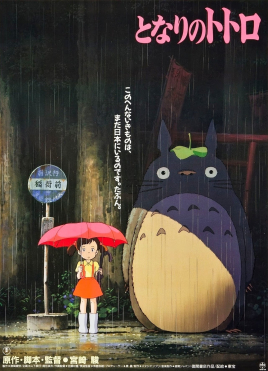My Neighbor Totoro, by Hayao Miyazaki
My Neighbor Totoro (1988) is a quiet, calm, beautiful film. There is no dialogue for very long stretches of story while characters explore, watch, and discover—akin to the opening sequence of WALL-e. There is no sass talk, there are no quick cuts, no pop-culture references, and no special effects. Nothing explodes. The movie is rated G. It is a hand-drawn animated film made a quarter-century ago. I watched it together with my two children, aged 3 and 4. They were absolutely riveted. So was I.
See this film.
Totoro is one of the earliest masterpieces from the legendary Studio Ghibli, a Japanese animation house. Ghibli’s best known recent work includes the incomparable Spirited Away (2001), Howl’s Moving Castle (2004; see our review here), and Ponyo (2008), all directed by Hayao Miyazaki. Miyazaki’s films regularly appear on the lists of greatest movies, and Spirited Away won the Oscar for Best Animated Film. But Totoro is the original on which Ghibli and Miyazaki built their reputation.
Totoro follows two sisters as they and their dad move into a new house in the countryside. The two girls explore the house and the surrounding woods, encountering magical woodland creatures along the way. The girls’ mother is sick, but gets better. The end.
The plot summary sounds a little dull. It is a good illustration of the principle that what matters is not what a movie is about, but how it is about it. (Although you can take that principle too far. I cringe every time I hear someone praise The Battleship Potemkin or The Birth of a Nation as great films. They were technically proficient propaganda films for evil causes. Human sin is ingenious enough to twist genuinely creative artistry to wicked ends.) 
A description of Totoro’s plot doesn’t do it justice. The whole point of Totoro is its atmosphere, the sense of the world it conveys. I’ve written elsewhere in praise of stories that reflect and celebrate the enchantment of the world. Totoro is one of them. Old houses are populated by soot sprites—little balls of black dust that scurry about in the shadows. They’re a little creepy, but ultimately harmless. In the woods you find creatures akin to a cross between a rabbit and teddy bear, some small, some extremely large. The big one is the eponymous Totoro.
These creatures don’t accommodate themselves to the children. They’re frankly weird, a little scary, and do their own thing. This isn’t a baby-proofed world: real danger lurks here and there. It is an enchanted world, but that doesn’t mean its Disney Land. The girls explore, not fearlessly, but despite their fear. The movie is more respectful of the children in its audience by showing that children, too, experience the world full of dangers and mysteries, not simply as a padded crib.
I appreciated the interaction between the adults and children in this film. The girls are always respectful, but they don’t stop being children: energetic, a little wild, and fiercely imaginative. The adults neither condescend to the girls by merely pretending to believe in the spirits, nor bludgeon them with an insistent materialist by telling them to stop believing in childish nonsense. Instead, they encourage the girls’ belief in spirits and sprites largely, one thinks, because they also believe.
Some Christians may object to mild hints of paganism implicit in the film. Some characters speak and bow to a tree; others pray at what I took to be a Buddhist shrine. These brief scenes didn’t bother me. I’d rather my kids grow up thinking of trees as something to be respected than an object to be used (the creation mandate is for us to exercise dominion, not domination). As for the Buddhism, the positive portrayal of any religiosity in cinema is so rare that I’ll take what I can get.
The movie leaves us with a question. Are the kids just making all this magical stuff up as a psychological crutch to cope with their mother’s illness? That seems to be one way of reading the film. When trials come, we flee to fantasies for relief. Certainly children do such things. In one scene they see a massive tree grow overnight, but the next morning it is gone, suggesting they imagined the whole thing.
But the movie leaves small hints that makes it hard to dismiss the supernatural so easily. Totoro gives them a small gift, which is still there the next day. Later he takes them to see their mother, and they leave a small gift which she really receives. Such small evidences act like faint traces of the enchantment that surrounds them, hinting at a benevolent love that surrounds and cares for them even when they’re not looking.












